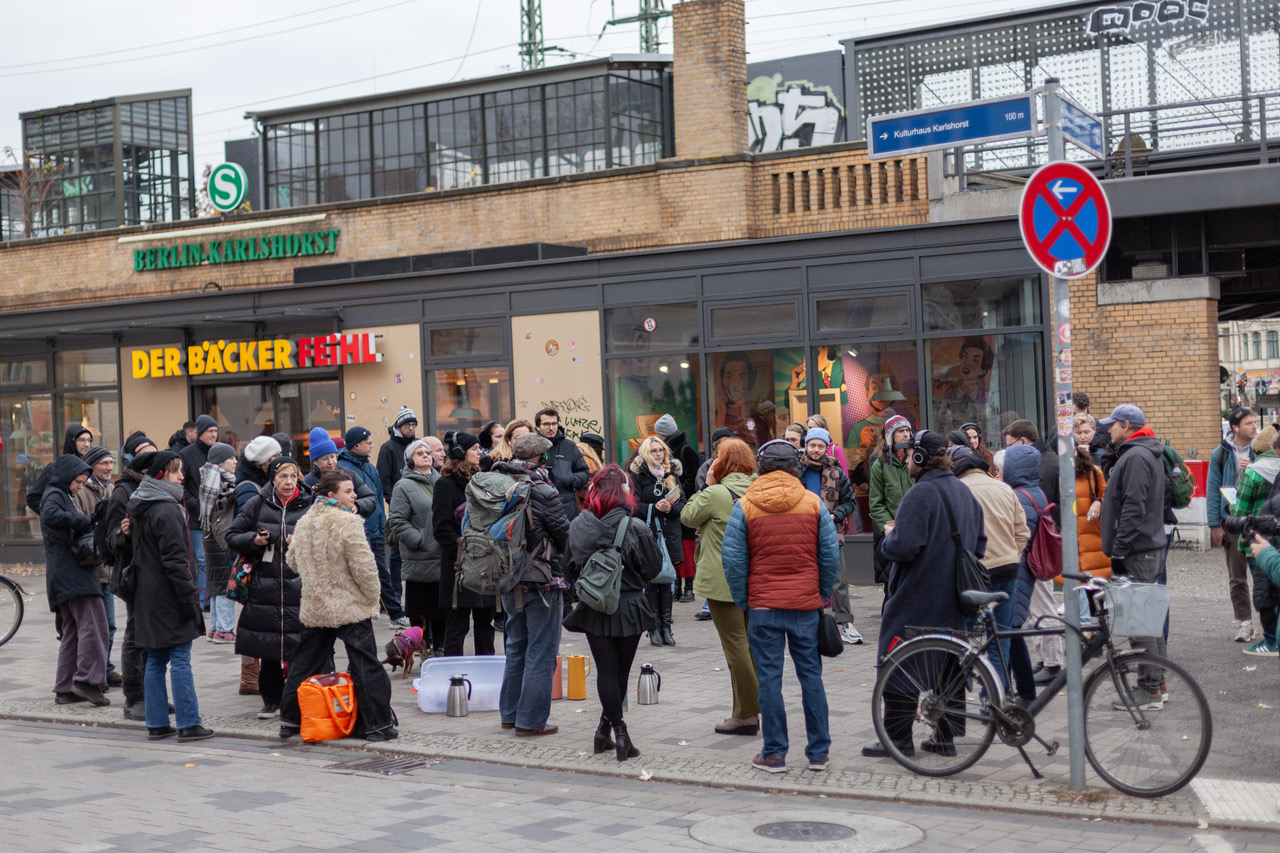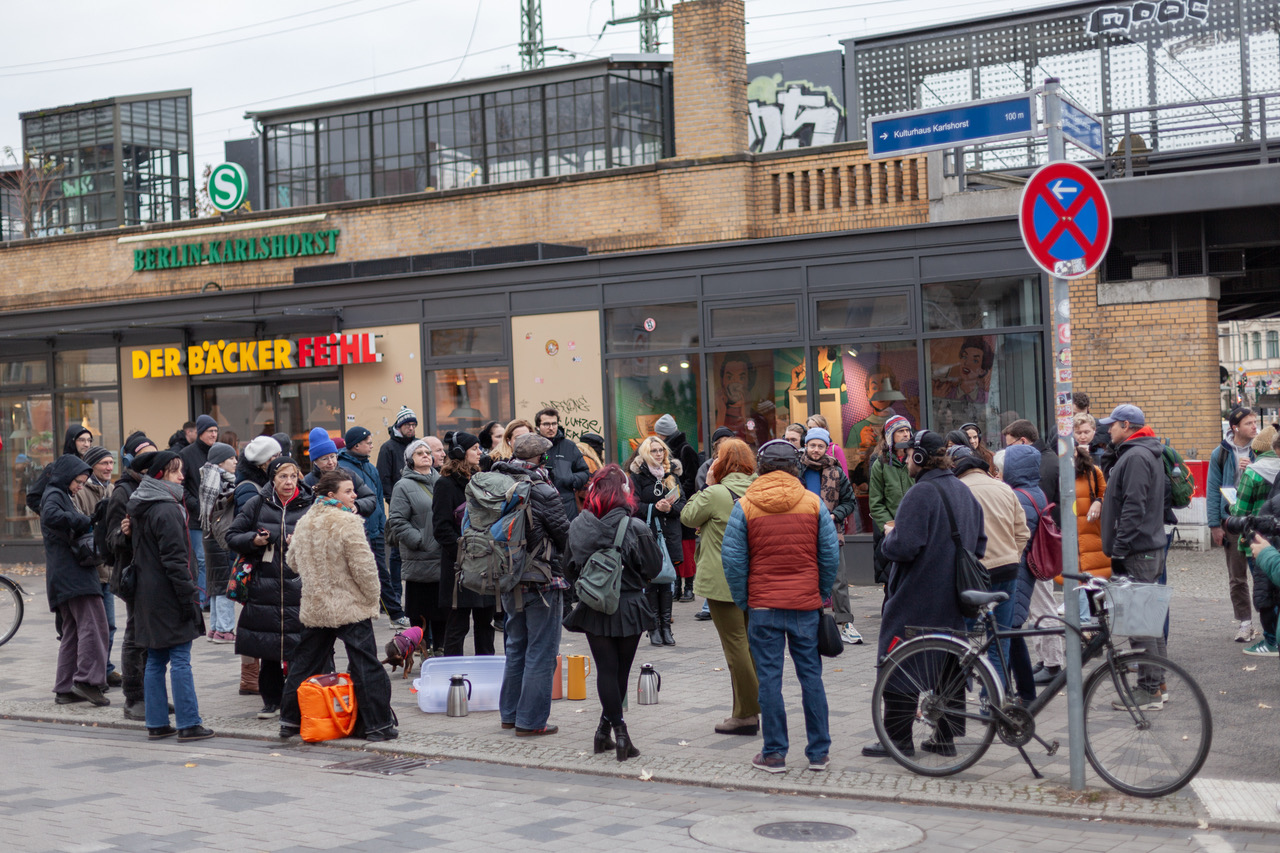
Audiowalk "and let no one be forgotten"

Photo: Katya Romanova
S-Bahn Karlshorst
Bakery at S-Bahn Karlshorst
and
The walk to Odessaplatz
The audio walk begins in front of the Feihl bakery at the Karlshorst S-Bahn station and leads from here to Odesaplatz, where Caro and Marianne talk, among others about her favorite cake from GDR times.
Location: Bakery at S-Bahn Karlshorst
CARO:
I wonder if much has changed or if you’ll feel the same being back here.
MARIANNE:
Yes, I’m curious to see it again after all this time.
CARO:
I want you to paint a picture for me of your childhood here. What was it like?
MARIANNE:
Oh, I don’t know. Where do I even start? Well… Bakeries like this one didn’t really exist back then. Not here. And getting coffee certainly wasn’t a thing yet.
CARO:
Karlshorst was a little slow on the uptake huh?
MARIANNE:
You could say that.
CARO:
So what… people just baked their own bread?
MARIANNE:
Ah no, we did have bakeries, but not like this. You couldn’t just sit in them like we are now. I do
remember as kids, we’d go to the bakery, and since the cakes were baked on large trays, they’d trim the
edges. For 20 pfennigs or so, you could get a little bag of cake edges.
CARO:
I wish they’d still do that now. I’d take some cheap cake trimmings.
MARIANNE:
The bags were filled with random cakes, but I used to save all the bits from my favorite cake—
CARO:
Bienenstich?
MARIANNE:
Yes, bienenstich! I’d save them 'til the end.
CARO:
Did you like growing up here?
MARIANNE:
I loved it.
CARO:
What was it that you loved?
MARIANNE:
It was like a little village back then. The world felt smaller. We looked out for each other. And it was slower. Not this ‘go go go’ of today. People stopped to talk on the street… It was community. We had community.
I remember there were still men who would come around with blocks of ice. They carried the blocks on a frame on their shoulder, hacking into them with ice picks, and brought them into the houses for the old ice boxes.
CARO:
That sounds straight out of a film.
MARIANNE:
Yes (she chuckles). And every Wednesday at 6, one of them would ring a bell and call out: “Firewood for potato peels, firewood for potato peels!” And we’d all run upstairs, grab the bowl—there was a special brown bowl with a hole in it where we’d been saving the potato peels all week—and bring it down to
him. He’d weigh the potato peels and give us just as much fine kindling wood in return. It was important for lighting the boiler. I remember that so clearly!
And on Gundelfingerstraße, there was—even though no one believes it now, but I swear—others remember too. In the front part of Gundelfingerstraße, there was a cow kept in a yard—it was milked every day. And in the next yard, there was still a blacksmith, not for gold but for shoeing horses. We watched from a respectful distance, totally fascinated.
It seemed simple and easy somehow.
CARO:
Easy?
MARIANNE:
This reminds me of Benjamin, in Experience and Poverty, who wrote about a generation that went from riding horse carts or sleds to school, to suddenly facing the most modern technology. And that’s how it was for me too!
In the 50s, we played in the street because there were hardly any cars. We used to play games like “Master, Master, give us work” across the streets, where one kid would call from the other side. No one told us to get off the roads because it was completely safe.
CARO:
You can bet that’s changed now.
MARIANNE:
I also remember collecting glass bottles as a popular activity. It was sometimes even required. Recycling, or "Zero Waste" as we'd call it today, was a big topic in the DDR from the very start.
We’d get a few pennies for each bottle or jar. Sometimes we had to do it for the Pioneers. Otherwise, we'd just go door-to-door with a little handcart, asking, "Bottles, jars, or old paper?" And people would say, "Yeah, check downstairs!" And so we'd collect everything, and that was our pocket money.
CARO:
Where could you take them?
MARIANNE:
Oh, to a collection point. There was one right next to the school. I don’t know when they got rid of that, probably when the yellow recycling bags came in. We could do that until about the age of 14 I’d say. No need for any permission.
CARO:
Permission? Hmm… and what about the Russian presence? It must have… I mean… did you notice them?
Were they around?
MARIANNE:
Of course. There was quite a large area that was fenced off. The Sperrgebiet.
CARO:
This is where the Russians lived?
MARIANNE:
It’s mostly where the higher-ranking soviet officials and their families lived, yes. There was also the barracks.
CARO:
Where was ‘the zone’?
MARIANNE:
It kept changing. Every few years it would shrink. But when I was a child I remember the fence ran along Treskowallee.
CARO:
Wasn’t it strange to have these areas where you couldn’t go?
MARIANNE:
Not really.
CARO:
It just seems so wrong that people weren’t able to get into a place they once might even have lived.
MARIANNE:
That’s how it was back then. But I didn’t know any different. It only seems strange now. That was my world. Some places you didn’t go.
CARO:
Hmm… how did you feel towards the Russians?
MARIANNE:
Well, my parents, your great-grandparents, were left-leaning. So I didn’t really experience it as a negative. There may well have been a lot of resentment and hostility. But I know for sure that people felt sorry for the soldiers. It trickled down to us how badly ordinary soldiers were treated. Some even tried to escape from time to time. But if they got caught—that was really life-threatening, or they’d end up in a military prison. Apparently, they were poorly supplied in the barracks and didn’t have enough clothing. People truly felt sorry for them. They were young men, and they only got about one day off a month. Even then, they weren’t allowed to stroll around or anything but had to go on group outings, like to the zoo, for example. I mean, I’m sure that was exactly what young men were most interested in (laughs ironically).
So, ordinary soldiers weren’t allowed to walk freely around Karlshorst. But the families were.
CARO:
It's strange to hear you talk about them sympathetically.
MARIANNE:
They were just people.
CARO:
Sure. But that’s a pretty simplistic way of looking at it, Oma. There was also a huge KGB base here, so
Karlshorst especially would have been under intense surveillance.
MARIANNE:
Well yes, but I don’t remember that really.
CARO:
Were there tensions between the Germans and Russians though? I thought Russians received more preference for things that were in limited supply. Surely there must have been tensions there. A frustration that they were getting stuff before Germans. In Germany…
MARIANNE:
That’s not necessarily true. They didn’t always get things first. It was a complicated time and supplies would change drastically for everybody. One thing I remember, they used to glue newspapers on the windows instead of curtains. Can you imagine that? I don’t know if it was our Neues Deutschland or the Pravda, but they would put them onto the window panes. You couldn’t see inside. And you couldn’t see out either! So, getting curtains must have been really complicated for them somehow.
CARO:
In this article I was talking about the other day it mentioned these Russian houses that have been empty since the Abzug. Do you know them?
MARIANNE:
Yes. They were in the Sperrgebiet.
CARO:
It’s a really long time for them to remain empty. I can’t believe no one has moved in.
MARIANNE:
Well, they’re still owned by Russia.
CARO:
Maybe they’ll still have newspaper on the windows… shall we go see them?
MARIANNE:
I’ll show you where the Sperrgebiet was on the way…
Location: The walk to Odessaplatz
Jeremy Knowles:
‘The great play is almost over.’
This was the closing line of a Guardian article published on the 11th of February, 1994, in which the author reflected on the Russian withdrawal from Karlshorst. At the time, General Matvei Burlakov, head of the Russian forces in Berlin, assured the press that no Russian "bullet, grenade, or mine would be left on German soil." Yet, over thirty years later, the final curtain has still to fall on this great piece of Cold War theatre. The Russian ordinance and ammunition may be gone from Germany, but other relics linger.
Welcome to and let no one be forgotten! - an audiowalk through Karlshorst inspired by the peculiar history of several houses here that have remained empty and largely untouched since 1994. This story is not only about the houses themselves but also about the different people who have come into contact with them, directly or indirectly, over the years. It is a story about what (and who) gets left behind after empires fall.
My name is Jeremy Knowles and I’m one of the three artists who have collaborated to create this audiowalk. Collectively, we represent three of the four allied nations that signed the German Instrument of Surrender in 1945, thus ending the Second World War. Though we are not German and did not grow up in Karlshorst, we share a part in its history. Our lives have been touched by the events that took place here.
The inspiration for this project came from a walk I took through Karlshorst in 2023 from my home in Lichtenberg. It was then that I first came across the houses on Andernacherstraße and Königswinterstraße and stood in bewilderment at their emptiness - their quietness - their stillness.
I wondered what the people who now live closest to the houses might think of the history they embody so clearly to me. I wondered how it might feel to live in such proximity to these crumbling and seemingly forgotten monuments to the Soviet occupation of East Berlin. Does this turbulent period of German history still feel present in Karlshorst, three decades later?
It’s ‘all a question of memory and forgetting’, noted the author of the same Guardian article back in
1994.
…Memory.
…And forgetting.
It’s as if, even at the time that this article was written, there was an awareness of the near-impossible task lying ahead of East Germans to close one chapter of history and simultaneously bear witness to the unshakable present moment - one coined by Francis Fukuyama as ‘the end of history’.
We’re going on a walk together.
Turn around with your back to the station. You should be facing the Havanna Bar now. Follow
Treskowallee north until you reach Odesa Platz. It’s about a two-minute walk but take your time. We’re
in no rush.
In unravelling these questions about Karlshorst’s Soviet past, about memory, division, and identity, I was reminded of the sci-fi novel Roadside Picnic, written by the Strugatsky brothers in 1972, in which the protagonists venture into mysterious forbidden zones.
These zones are presumed to have been visited by aliens, though this visitation was never witnessed - no aliens were actually observed. Instead, the humans depicted in Roadside Picnic are forced to reckon with the prospect that extra-terrestrial beings came to Earth and found nothing of interest. The aliens didn’t stick around long enough to realise that pinnacle moment in Western sci-fi stories: the first encounter between species.
Only the most expert scientists are allowed to enter the zones. But there are those who cross into the zones without permission - the Stalkers. In turn, the Stalkers become consumed by the zones, returning home each time having been changed. Their worldview altered. Their very humanity unclear.
For me… Roadside Picnic is a story about inclusion. It asks the question: what does it mean to live in a world that is defined by borders we’re not supposed to cross?
Early in the novel, a scientist explains his theory about the aliens through his metaphor of a picnic…
Quote - Roadside Picnic:
Noonan jumped. “What did you say?”
“A picnic. Imagine: a forest, a country road, a meadow. A car pulls off the road into the meadow and unloads young men, bottles, picnic baskets, girls, transistor radios, cameras … A fire is lit, tents are pitched, music is played. And in the morning they leave. The animals, birds, and insects that were watching the whole night in horror crawl out of their shelters. And what do they see? An oil spill, a
gasoline puddle, old spark plugs and oil filters strewn about … Scattered rags, burntout bulbs, someone has dropped a monkey wrench. The wheels have tracked mud from some godforsaken swamp … and, of course, there are the remains of the campfire, apple cores, candy wrappers, tins, bottles, someone’s handkerchief, someone’s penknife, old ragged newspapers, coins, wilted flowers from another meadow
…”
“I get it,” said Noonan. “A roadside picnic.”
“Exactly. A picnic by the side of some space road. And you ask me whether they’ll come back …”
Location

